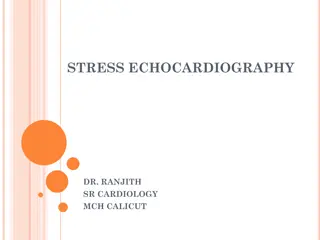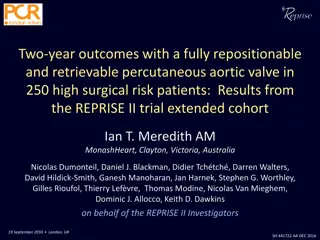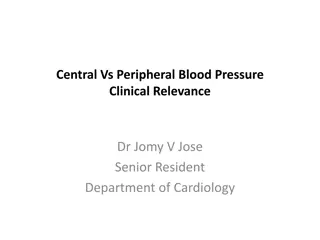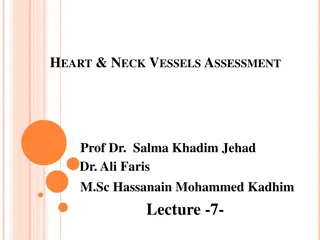Advances in Trans-Catheter Aortic Valve Replacement: A Comprehensive Review
This presentation explores the evolution of Trans-Catheter Aortic Valve Replacement (TAVR), highlighting historical milestones, anatomical considerations, the role of Balloon Aortic Valvuloplasty, current guidelines, the need for TAVI, and a notable case study by Dr. Cribier. The content discusses t
2 views • 85 slides
Understanding Coronary Artery Bypass Graft (CABG) in Adult Nursing
Coronary Artery Bypass Graft (CABG) is a surgical procedure where a blood vessel from another part of the body is grafted onto an occluded coronary artery to bypass blockages. This procedure is less common in women compared to men and is typically indicated for severe coronary artery disease. It is
5 views • 15 slides
Management of Foramen Magnum Stenosis in Achondroplasia Workshop Overview
Workshop on the detection and management of foramen magnum stenosis in individuals with achondroplasia took place on 6th April 2022. The event focused on challenges, screening protocols, intervention indicators, decision-making processes, and management strategies. Key outcomes include reaching an a
0 views • 11 slides
Understanding the Blood Supply of the Brain
The brain receives its blood supply from four major arteries - two vertebral arteries and two internal carotid arteries. The vertebral arteries branch into the basilar artery, which gives rise to various important branches. The internal carotid arteries supply the anterior and middle cerebral arteri
1 views • 30 slides
Otitis Externa: Overview, Risk Factors, and Treatment
Otitis externa, also known as swimmer's ear, is an inflammation of the external auditory canal. It can be acute or chronic and is common among individuals aged 7-14 years. The main causative organisms include Pseudomonas aeruginosa and Staphylococcus aureus. Risk factors include swimming in pools, h
0 views • 10 slides
Cardiac Diseases in Pregnancy: Implications and Management
Normal pregnancy induces significant physiologic changes in the cardiovascular system, which can impact women with pre-existing cardiac diseases. Understanding the New York Heart Association classification scheme is crucial for assessing symptomatology during pregnancy. Rheumatic Heart Disease, part
0 views • 12 slides
Neonatal Vomiting: Causes, Diagnosis, and Differential Diagnosis
Neonatal vomiting can be a concern when presenting with bile-stained or blood-stained vomit, projectile vomiting, or associated with weight loss and failure to grow. Various non-surgical and surgical conditions like Pyloric Stenosis can lead to vomiting in neonates. Common causes include Mid-gut vol
0 views • 16 slides
Comprehensive Guide to Stress Echocardiography in Cardiology Practice
Stress echocardiography is a valuable tool in diagnosing and managing coronary artery disease, valvular heart disease, and assessing heart function. This imaging technique helps in detecting flow-limiting stenosis, understanding the ischemic cascade, and evaluating cardiac function during stress. Va
0 views • 49 slides
ACST-2 Trial: Stenting vs. Surgery for Carotid Artery Stenosis
ACST-2 is a randomized trial comparing carotid artery stenting (CAS) versus carotid artery surgery (CEA) in asymptomatic patients with severe carotid stenosis. The trial, published in The Lancet in August 2021, involved 3625 patients. While surgery has been shown to reduce stroke rates, modern medic
0 views • 19 slides
Ticagrelor Added to Aspirin in Acute Non-Severe Ischemic Stroke or TIA of Atherosclerotic Origin
Among patients with transient ischemic attack (TIA) or minor ischemic strokes, adding ticagrelor to aspirin has shown superior efficacy in preventing stroke or death, particularly in those with ipsilateral atherosclerotic stenosis. The THALES trial demonstrated that ticagrelor added to aspirin was m
0 views • 14 slides
Understanding Atherosclerosis, Peripheral Artery Disease, and Carotid Stenosis
This informative content details the histo-anatomy of blood vessels, pathophysiology of atherosclerosis, peripheral ischemia, and carotid artery disease. It covers the definition, risk factors, and processes involved in atherosclerosis, including endothelial cell function, blood flow dynamics, and f
3 views • 24 slides
Understanding Spinal Canal Stenosis: Causes, Symptoms, and Classification
Spinal canal stenosis is the abnormal narrowing of the spinal canal or intervertebral foramina, leading to compression of nerves and blood vessels. It can result in symptoms such as radiculopathy, claudication, myelopathy, and more. Cervical stenosis presents with arm pain and weakness, while lumbar
0 views • 18 slides
3-Year Outcomes of a Randomized Trial Comparing a Self-expanding to a Balloon-expandable Transcatheter Aortic Valve
Investigating the long-term effects of two transcatheter aortic valve systems in patients with severe aortic stenosis, this study follows 739 participants over a 3-year period. The trial compares the ACURATE neo and SAPIEN 3 devices, focusing on early safety and clinical efficacy at 30 days with fol
0 views • 26 slides
Comparison of Valve Types and Anesthesia Strategies in Transcatheter Aortic Valve Implantation
In the SOLVE-TAVI trial, patients undergoing transcatheter aortic valve implantation were randomized to receive either self-expandable or balloon-expandable valves under general or local anesthesia. The study aims to compare the effectiveness and safety of different valve types and anesthesia approa
0 views • 27 slides
Challenges and Techniques in Native RVOT Stenting for TOF+PS Patients
Native RVOT stenting in TOF+PS patients can be challenging due to anatomical complexities like short infundibulum and VSD. Different equipment and techniques are used for crossing tricuspid and pulmonary valves and delivering the stent. Dilating the pulmonary valve and addressing residual stenosis a
0 views • 22 slides
Understanding Carotid Endarterectomy: A Comprehensive Overview
Carotid endarterectomy is a crucial vascular operation aimed at improving outcomes for patients at risk of stroke. This procedure targets the removal of plaque build-up in the carotid arteries to prevent further cerebrovascular events. The surgery's effectiveness is highlighted by its impact on redu
0 views • 12 slides
Understanding Heart Sounds and Murmurs in Cardiovascular Physiology
This detailed lecture covers the basics of normal and abnormal heart sounds, stethoscope placement, cardiac auscultation, and the physiological significance of heart murmurs. It explains the causes, descriptions, and grading of abnormal heart sounds, along with specific conditions like aortic stenos
0 views • 26 slides
Two-Year Outcomes with Fully Repositionable Aortic Valve in High Surgical Risk Patients
The REPRISE II trial extended cohort evaluated the Lotus Valve System's safety and performance in symptomatic patients with severe aortic stenosis at high risk for surgical valve replacement. This prospective, single-arm study assessed the valve system's effectiveness through various follow-ups and
0 views • 19 slides
Radiology Imaging of Esophagus and Stomach by Dr. A. Alhawas
View detailed radiology imaging of the esophagus and stomach conducted by Dr. A. Alhawas, showcasing various anatomical structures such as the splenic artery, abdominal aorta, common hepatic artery, and more. Explore pathologically changed layers in pyloric stenosis, arterial blood supply to the pyl
0 views • 8 slides
Detection and Management of Foramen Magnum Stenosis in Achondroplasia Workshop
The workshop focused on understanding challenges and implications of foramen magnum stenosis in individuals with achondroplasia. It aimed to review protocols for screening infants, evaluate intervention indicators, and reach a consensus on optimal detection and decision-making processes for decompre
0 views • 11 slides
Endovascular Interventions at Mount Sinai Hospital: Case Study
Division of Endovascular Interventions at Mount Sinai Hospital, New York, treated a 71-year-old female patient with bilateral lower extremity claudication using endovascular procedures. The patient had a history of hypertension, diabetes, hyperlipidemia, and smoking, with peripheral artery disease a
0 views • 27 slides
Evolut Low Risk Bicuspid Study Analysis
This study aims to evaluate the safety and efficacy of transcatheter aortic valve replacement (TAVR) in low-risk patients with bicuspid aortic valve stenosis. TAVR with Evolut valves has shown promising results in tricuspid aortic stenosis, but data on bicuspid cases are lacking. The participating s
0 views • 27 slides
Advancing Vascular Ultrasound Through Registry Collaboration
The Vascular Ultrasound Registry Pilot Project, led by Dr. David Dawson and Dr. Gregory L. Moneta, aims to enhance research, education, and quality in vascular ultrasound. This initiative involves a formal collaboration between SVS PSO, SVU, and M2S/Medstreaming to integrate images and data into cli
0 views • 19 slides
Clinical Outcomes in Microsurgery for Lumbar Disc Herniation: Prospective Study
This prospective study examined the clinical outcomes in patients undergoing microsurgery for lumbar disc herniation and spinal stenosis. The study evaluated the effectiveness of surgical intervention using the Oswestry Disability Index (ODI) and Numeric Rating Scale (NRS) questionnaires preoperativ
0 views • 13 slides
Pediatric Intestinal Obstruction: Causes, Symptoms, and Management
Pediatric intestinal obstruction in newborns and older children can result from various conditions such as foregut obstruction, midgut obstruction, and hindgut obstruction. Common causes include esophageal atresia, pyloric stenosis, and Hirschsprung disease. Diagnosis involves clinical evaluation, i
0 views • 81 slides
Understanding Central vs Peripheral Blood Pressure: Clinical Relevance
Central vs peripheral blood pressure differences have clinical implications as systolic pressure amplification occurs due to changes in arterial stiffness moving away from the heart. Central pressure measurements, more closely related to cardiovascular events, provide valuable insights for assessing
3 views • 25 slides
Carotid Endarterectomy Review and Case Discussion
Division of Vascular Surgery at the University of Utah School of Medicine, led by Dr. Benjamin S. Brooke, MD, PhD, conducted a session on Carotid Endarterectomy, including a de-identified case review, discussion on variable variations, and Q&A for CEA VQI abstraction. The session highlighted limitat
0 views • 28 slides
Heart and Neck Vessels Assessment Overview
This information presents a comprehensive guide for heart and neck vessels assessment, including objectives, necessary equipment, preparation steps, subjective data to consider, techniques for palpating and auscultating the carotid artery, normal findings, and more. It emphasizes the importance of s
0 views • 23 slides
Understanding Mitral Stenosis: Causes, Symptoms, and Pathophysiology
Mitral stenosis is a valvular heart disease characterized by narrowing of the mitral valve orifice, leading to decreased blood flow and various complications. Rheumatic fever is a common cause, with thickening and calcification of valve tissue leading to pulmonary hypertension and heart failure. Exp
0 views • 31 slides
Comparison of Self-Expanding Bioprostheses in Transcatheter Aortic Valve Replacement
The SCOPE II randomized clinical trial compared the early and mid-term performance of the ACURATE neo and CoreValve Evolut self-expanding bioprostheses for transcatheter aortic valve replacement in patients with severe aortic stenosis. The study devices differed in features such as expansion, recapt
0 views • 24 slides
Critical Review of TAVR in Low-Risk Bicuspid Patients
TAVR has shown promising outcomes in tricuspid aortic stenosis but has not been extensively studied in low-risk bicuspid patients. The Low Risk Bicuspid Trial aims to evaluate the procedural and short-term outcomes of TAVR in this patient population through a prospective study involving 25 centers.
0 views • 21 slides
Understanding Arteries: Anatomy and Function Overview
Explore the key concepts related to arteries, including their definition, anastomosis, end arteries, aorta divisions, and major artery distribution in the body. Learn about the general principles of arteries and their role in blood circulation, emphasizing the importance of anastomoses. Dive into th
0 views • 21 slides
Embryology of the GI Tract and Development of the Gut Tube
Embryology of the gastrointestinal (GI) tract involves the formation of germ layers during gastrulation, leading to the development of endoderm, mesoderm, and ectoderm. By incorporating the yolk sac, the primitive gut tube emerges during weeks 3-4 and is divided into foregut, midgut, and hindgut, gi
1 views • 25 slides
Spinal Stenosis - Hind Spine clinic
At Hind Spine Clinic, Bhopal, we specialize in treating spinal stenosis, a condition that can significantly impact daily life due to chronic pain and discomfort. With advanced and effective treatment options, our expert team is dedicated to helping p
3 views • 6 slides
Exploring the Latest Research on Carotid Artery Disease Treatment
This comprehensive update discusses recent findings and ongoing studies related to carotid artery disease treatment options, particularly focusing on revascularization procedures in symptomatic and asymptomatic patients. Key trials like ECST-2, ACTRIS, EVA-3S, SPACE, ICSS, CREST, and more are highli
0 views • 25 slides


































